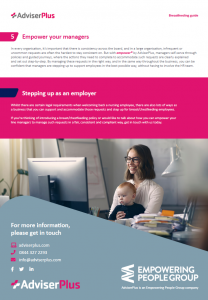World Breastfeeding Week 2023
World Breastfeeding Week is held in the first week of August every year, organised every year by the World Alliance for Breastfeeding Action (WABA).
This year the theme is breastfeeding and employment. There are many different demands on new parents, which sometimes mean that those who want to breast/chestfeed may lack the support to sustain that choice. Busy routines, along with the many other challenges that parents face can mean that they don’t feel that breast/chestfeeding their child when they return to work is something that is accessible or practical. However, this doesn’t have to be the case and there are way organisations can help facilitate those who wish to continue their child’s feeding routine on their return to work.
So, for World Breastfeeding Week 2023, how can workplaces step up? Click this link to download our guide to find out.
Championing the needs of employees
When it comes to welcoming back nursing employees, meeting legal requirements is just the beginning. As a business, there are a lot of practical ways to support and accommodate breast/chestfeeding employees.
If you’re considering a breast/chestfeeding policy or need help empowering your line managers to handle these requests in a fair, consistent and compliant way, contact us today.
